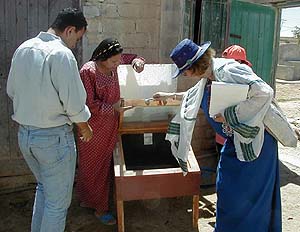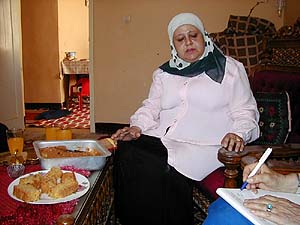
University Graduates Discover Solar Cooking Benefits
Every time I am in Switzerland I contact Group ULOG, a solar energy organization founded in 1980 by Ulrich and Lisel Oehler. I am indebted to Ulrich, who introduced me to solar cooking in 1985.
Recently, I spent time in their home-office looking through new English versions of ULOG’s documentation and discovered information on solar cooking in Egypt. A trip to Egypt was on my agenda for July 2000. Amidst the documents were intriguing reports of an elementary school teacher from Berne, Switzerland, who has spent one month each summer since 1993 teaching solar cooking in Egypt.
The teacher, Annemarie Wenger-Marti, trains women to solar cook, and requires them to keep notes so that she can monitor progress each year. Annemarie impressed me as being a well-organized, demanding Swiss schoolteacher. In addition to her work in Egypt, she teaches solar cooking to local school children, including a group of fourth graders who built solar box cookers and used them on a 5-day camping trip! This past July I called Annemarie and told her I wished to do a site visit to the areas where she had been training and interview some of her students. With her permission, I headed off for Egypt to meet her contact, Dr. Wadid Eriam, a professor and soil specialist at Cairo University.
Dr. Eriam, who spoke highly of her teaching skills, set up Annemarie’s training program in 1990 as part of the larger Homestead Project. Goals of this unique project include: desert reclamation, employment and land-ownership assistance for agronomy students, and the creation of towns. Annemarie’s students are literate, university graduates in agronomy, who made an independent choice to learn how to solar cook. They have the means to cook with gas if they choose. I have worked with refugees in Kenya and Ethiopia who needed solar cooking for survival, but haven’t met cooks who had the freedom of choice – to decide for themselves to solar cook. They each paid US $30 for a locally built ULOG solar box cooker.

Louise admiring a ULOG cooker at work.
Our first interview was with Mona Abdul Hakim of El Zohour, located in the Hamam Zone + Tiba Zone, popularly called the sugar beet zone, about an hour southwest of Alexandria. The day we arrived Mona was cooking beans and hard-baked eggs, in addition to drying watermelon seeds. She solar cooks most all local foods, including meat, eggplants, potatoes, fig marmalade, and a dish of stewed apples in shredded coconut. In the winter months she makes yogurt.
Mona showed us her notebook, with solar cooker drawings and Arabic text, and a tote bag Annemarie had sewed and embroidered to carry food and a pot in. Mona likes to cook because she can put food out and forget about it – without worry of it burning. Her family finds the food tastier and healthier than conventionally-cooked food. Since learning to solar cook in 1998 she has become president of the El Zohour Solar Cooking Club, with the duty of organizing monthly potluck lunches where participants share news and recipes.
The second interview was with agronomist Nahed Jussef and her husband Hashraf, who live in Zone #22. Like Mona, Nahed is enthusiastic about the benefits of solar cooking and is president of a local solar cooking club. Nahed and her mother learned to solar cook in 1998. Some of the foods she cooks are beans, dried peanuts, stuffed grape leaves, zucchini with rice and peppers, chicken livers, tomato soup and cakes.
Next we drove to Zone #17 where we were welcomed by Hala Mustafa, the most dynamic woman of the three. She’s a real solar cooking enthusiast with an entrepreneurial spirit. Hala told us that she had established a small business selling yogurt that she made in her ULOG solar cooker. In addition, she proudly showed us the Arabic-English cookbook Annemarie edited with her students that Hala would like to see published. Anxiously awaiting our visit, Hala had baked a cake with raisins just for us. She gave me the recipe: 5 fresh eggs, 1/2 kg. flour, 200 gr. sugar, 200 gr. butter, baking powder, and vanilla. She had chickens in her yard where her cooker was set up – the fresh eggs made the cake so much better! She let us taste the apricot marmalade and smell the solar-dried peppermint leaves. Otherwise her solar meals include: fish, beef, duck, mutton, rice, stuffed green peppers, stewed apples, dried peanuts, and watermelon seeds. She cooks every day.
 As we were about to leave, she took us over into her neighbor’s yard. There, to our great surprise, we saw what looked like preparation for a birthday party! Hala’s neighbor was baking two batches of creme caramel, one soft, one harder; and stewed apples, cored and stuffed with nuts and honey, laid out in a circular fashion in shredded coconut.
As we were about to leave, she took us over into her neighbor’s yard. There, to our great surprise, we saw what looked like preparation for a birthday party! Hala’s neighbor was baking two batches of creme caramel, one soft, one harder; and stewed apples, cored and stuffed with nuts and honey, laid out in a circular fashion in shredded coconut.
These site visits incited me to want to learn more, even to have a video documentary made of these women that Annemarie had trained. Though I received answers to all of my original questions, I have many more. Who builds the cookers? How many potential new cooks are in this area? Did any of these cooks intend to become teachers to generate income one day? How much money do they save on gas?
Recently Annemarie organized the construction of two parabolic cookers made from mirrors built by Alec Gagneux, an associate of ULOG. These cookers are part of a cafeteria built on a huge farm north of Cairo, where 300 farm workers join to share lunch and rest indoors. I will report on this project in an upcoming Solar Cooker Review.
Contact: Group ULOG, Morgartenring 18, CH-4054 Basel, Switzerland.



